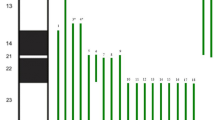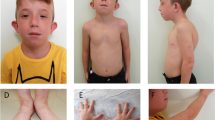Summary
The syndrome caused by partial trisomy for 11q is reviewed on the basis of a patient of our own and 20 cases (including a stillbirth) from the literature. The main symptoms are presented in Tables 1 and 2. The syndrome can be suspected when, in addition to mental retardation, the following characteristics are present: short nose, long philtrum, micrognathia, retracted lower lip, and micropenis in males. In 15 families, the mother was a balanced translocation carrier and in four the father. The translocation had arisen de novo in two patients. The chromosome number was 46 in 13 affected individuals (including the stillbirth) and 47 in eight. In seven of the latter patients the other translocation chromosome was 22, and in one, chromosome 9. The breakpoints on 11q ranged from 11q121 to 11q232 (Fig. 5). There is no apparent correlation between the length of the trisomic segment and the number or severity of the symptoms (Table 2). This could be explained by assuming that most, if not all, symptoms are caused by trisomy for the Q-dark region distal to 11q232, whereas trisomy for the rest of the 11q up to q121 has few phenotypic effects. These observations support the idea that Q-dark segments, and especially certain hot spots, have a high gene density in contrast with Q-brighter regions.
Similar content being viewed by others
References
Aurias A, Turc C, Michiels Y, Sinet P-M, Graveleau D, Lejeune J (1975) Deux cas de trisomie 11q (q231→qter) par translocation t(11;22) (q231;q111) dans deux familles différentes. Ann Genet (Paris) 18: 185–188
Ayraud GA, Galiana A, Lloyd M, Deswarte M (1976) Trisomie 11q (q23.1→qter) par translocation maternelle t(11;22)(q23.1;211.1). Ann Genet (Paris) 19:65–68
Bader PJ, Jansch M, Hoffman D, Palmer CG, Gerber H, Taylor G (1978) Trisomy 11q(q21→qter). Birth Defects 14, 6C:383–392
Barnabei VM, Wyandt HE, Kelly TE (1981) A possible exception to the critical region hypothesis. Am J Hum Genet 33:61–66
Burnham CR (1962) Discussions in cytogenetics. Burgess, Minnesota
Carlin ME, Neadle MM (1978) Cri-du-chat syndrome—a correlation between abnormalities and size of deletion. Birth Defects 14, 6C:428–429
Daniel A (1979) Structural differences in reciprocal translocations. Potential for a model of risk in Rcp. Hum Genet 51:171–182
Dinno ND, Silvey GL, Weisskopf B (1974) 47,XY,t(9p+;11q+) in a male infant with multiple malformations. Clin Genet 6:125–131
Feldman GM, Sparkes RS (1978) The problem of partial trisomy 22 reconsidered. Hum Genet 45:97–101
Fraccaro M, Lindsten J, Ford CE, Iselius L (1980) The 11q;22q translocation: A European collaborative analysis of 43 cases. Hum Genet 56:21–51
Francke U (1977) Abnormalities of chromosomes 11 and 20. In: Yunis JJ (ed) New chromosomal syndromes. Academic Press, New York San Francisco London, p 245
Francke U, Weber F, Sparkes RS, Mattson PD, Mann J (1977) Duplication 11(q21 to 23→qter) syndrome. Brith Defects 13, 3B:167–186
Giraud F, Mattei J-F, Mattei M-G, Bernard R (1975) Trisomie partielle 11q et translocation familiale 11–22. Hum Genet 28:343–347
Grouchy J de, Turleau C (1977) Clinical atlas of human chromosomes. John Wiley and Sons, New York Toronto
Jacobsen P, Hauge M, Henningsen K, Hobolt N, Mikkelsen M, Philip J (1973) An (11;21) translocation in four generations with chromosome 11 abnormalities in the offspring. Hum Hered 23:568–585
Korenberg JR, Therman E, Denniston C (1978) Hot spots and functional organization of human chromosomes. Hum Genet 43:13–22
Kuhn EM (1976) Localization by Q-banding of mitotic chiasmata in cases of Bloom's syndrome. Chromosoma 57:1–10
Laurent C, Biemont M-Cl, Bethenod M, Cret L, David M (1975) Deux observations de trisomie 11q (q23.1→qter) avec la même anomalie des organes genitaux externes. Ann Genet (Paris) 18:179–184
Lindenbaum RH, Bobrow M (1975) Reciprocal translocations in man. 3:1 meiotic disjunction resulting in 47- or 45-chromosome offspring. J Med Genet 12:29–43
Lurie IW, Lazjuk GI, Usova YI, Gurevich DB (1979) Partial trisomy 11q as the result of sporadic translocation. Hum Genet 51:63–66
Mann J, Rafferty JH (1972) Cri-du-chat syndrome combined with partial C-group trisomy. J Med Genet 9:289–292
Nakai H, Yamamoto Y, Kuroki Y (1979) Partial trisomy of 11 and 22 due to familial translocation t(11;22)(q23;q11), inherited in three generations. Hum Genet 51:349–355
Niebuhr E (1974) Down's syndrome. The possibility of a pathogenetic segment on chromosome No. 21. Hum Genet 21:99–101
Niebuhr E (1977) Partial trisomies and deletions of chromosome 13. In: Yunis JJ (ed) New chromosomal syndromes. Academic Press, New York San Francisco London, p 273
Niebuhr E (1978) Cytologic observations in 35 individuals with a 5p-karyotype. Hum Genet 42:143–156
Noel B, Levy M, Rethoré M-O (1976) Trisomie partielle du bras long du chromosome 11 par malségrégation d'une translocation maternelle t(11;22)(q231;q111). Ann Genet (Paris) 19:137–139
Patau K (1964) Partial trisomy. In: Second International Conference on Congenital Malformations. The International Medical Congress, New York, p 52
Ridler MAC, McKeown JA (1979) 11q aneuploidy: Partial monosomy and trisomy in the children of a mother with a t(3;11)(p27;q23) translocation. Hum Genet 52:101–106
Rott H-D, Schwanitz G, Grosse K-P, Alexandrow G (1972) C 11/D 13-translocation in four generations. Hum Genet 14:300–305
Tusques J, Grislain JR, André M-J, Mainard R, Rival JM, Cadudal JL, Dutrillaux B, Lejeune J (1972) Trisomie partielle 11q identifiée grace a l'étude en “denaturation ménagée” par la chaleur, de la translocation équilibrée paternelle. Ann Gene (Paris) 15:167–172
Wahrman J, Goitein R, Richler C, Goldman B, Akstein E, Chaki R (1976) The mongloid phenotype in man is due to trisomy of the distal pale G-band of chromosome 21. In: Pearson PL, Lewis KR (eds) Chromosomes today 5. John Wiley and Sons. New York Toronto, p 241
Wright YM, Clark WE, Brey WR (1974) Craniorachischisis in a partially trisomic 11 fetus in a family with reproductive failure and a reciprocal translocation t(6p+;11q-). J Med Genet 11:69–75
Yunis JJ (1965) Interphase deoxyribonucleic acid condensation, late deoxyribonucleic acid replication, and gene inactivation. Nature 205:311–312
Author information
Authors and Affiliations
Rights and permissions
About this article
Cite this article
Pihko, H., Therman, E. & Uchida, I.A. Partial 11q trisomy syndrome. Hum Genet 58, 129–134 (1981). https://doi.org/10.1007/BF00278696
Received:
Issue Date:
DOI: https://doi.org/10.1007/BF00278696




